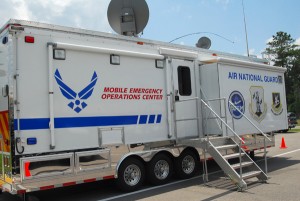New mobile operations center helps Air Guard communicate during disasters
Written by Sgt. 1st Class Blair Heusdens // May 25, 2012 // Feature Stories, News

The Florida Air National Guard's new Mobile Emergency Operations Center (MEOC) can be used by the military or other civilian agencies to provide communications during disasters.
STARKE, Fla. (May 24, 2012) – The ability to communicate during disaster response is critical. What’s even more important is for all agencies involved – military and civilian – to be able to communicate across different frequencies and networks.
Emergency managers from the Florida Air National Guard’s 125th Fighter Wing recently received a Mobile Emergency Operations Center (MEOC) with specialized communications platforms that can deploy and provide communications support during disasters. The vehicle is equipped with systems that can support both military and civilian frequency communications and communicate between different systems, if necessary.

An emergency manager with the Florida Air National Guard's 125th Fighter Wing scans the outside video feed from the Mobile Emergency Operaitons Center during the 2012 Statewide Hurricane Exercise at Camp Blanding Joint Training Center.
“If we just need to go support the Guard, we have the high frequency radios that will talk to any other military radio,” said Senior Airman Mitchell Snead, an emergency manager with the 125th. “If we need to support civilians, we can also do that.”
The MEOC made its first official debut supporting the 2012 Statewide Hurricane Exercise, May 21-24. The exercise was an opportunity to test out the vehicle’s capabilities and its ability to link up with other military communication systems at Camp Blanding Joint Training Center. The vehicle can be an asset during disasters to not only military, but also civilian responders, if needed.
“It’s designed so that any civilian can come in here and they can operate out of here as well,” said Snead.
The Air National Guard is fielding 25-30 of these vehicles throughout the country so that multiple vehicles will be available to each region for emergency response. For the Air Force Emergency Managers, it is one more tool that allows them to perform in their multi-functional roles supporting base emergency management and domestic operations, including responding to chemical, biological, radiological, nuclear and high-yield explosive (CBRNE) hazards.
“It’s an asset for us to better do our jobs,” said Snead. “[Being] an active duty emergency manager is base-centric, whereas [being in the National Guard] opens us up to all the domestic operations.”
###















